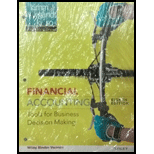
(a)
Accounting equation represents the relationship between assets, liabilities and shareholders’ equity. It is the foundation of double entry system and it helps to analyze the business transaction. Accounting equation displays the total assets are equal to the total liabilities and shareholders’ equities. Thus, the accounting equation is,
Journal:
Journal is the method of recording monetary business transactions in chronological order. It records the debit and credit aspects of each transaction to abide by the double-entry system.
Rules of Debit and Credit:
Following rules are followed for debiting and crediting different accounts while they occur in business transactions:
- Debit, all increase in assets, expenses and dividends, all decrease in liabilities, revenues and stockholders’ equities.
- Credit, all increase in liabilities, revenues, and stockholders’ equities, all decrease in assets, expenses.
T-account:
T-account refers to an individual account, where the increases or decreases in the value of specific asset, liability, stockholder’s equity, revenue, and expenditure items are recorded.
This account is referred to as the T-account, because the alignment of the components of the account resembles the capital letter ‘T’.’ An account consists of the three main components which are as follows:
- (a) The title of the account
- (b) The left or debit side
- (c) The right or credit side
To show: The effect of each transaction on the accounting equation and explanation for changes to
(b)
To journalize: the transaction given in the books of T Corporation
(c)
To post: the transaction to T-accounts of T Corporation as on September, 30.
Want to see the full answer?
Check out a sample textbook solution
Chapter 3 Solutions
Bundle: Financial Accounting: Tools for Business Decision Making 8e Binder Ready Version + WileyPLUS Registration Code
- Choice correct answer with accounting questionarrow_forwardZenith Components wants to evaluate its cash conversion cycle. Last year, it made $150,000 in credit sales and had a net profit margin of 8%. Its inventory turnover was 6.25 times, and the firm's DSO (Days Sales Outstanding) was 36 days. The annual cost of goods sold was $120,000, and the payables deferral period is 42 days. Use a 365-day year. What is Zenith's cash conversion cycle? Round your final answer to two decimal places.arrow_forwardWhat is the estimate net annual savings to the firmarrow_forward
- I don't need ai answer general accounting questionarrow_forwardCan you help me solve this general accounting problem using the correct accounting process?arrow_forwardA company is considering two different inventory valuation methods: FIFO (First-In, First-Out) and LIFO (Last-In, First-Out). Discuss the potential impact of each method on the company's financial statements during periods of rising prices. Which method would result in a higher cost of goods sold and lower net income?arrow_forward
- Principles of Accounting Volume 1AccountingISBN:9781947172685Author:OpenStaxPublisher:OpenStax College
 College Accounting, Chapters 1-27AccountingISBN:9781337794756Author:HEINTZ, James A.Publisher:Cengage Learning,Century 21 Accounting Multicolumn JournalAccountingISBN:9781337679503Author:GilbertsonPublisher:Cengage
College Accounting, Chapters 1-27AccountingISBN:9781337794756Author:HEINTZ, James A.Publisher:Cengage Learning,Century 21 Accounting Multicolumn JournalAccountingISBN:9781337679503Author:GilbertsonPublisher:Cengage



